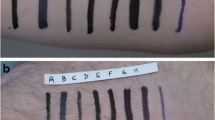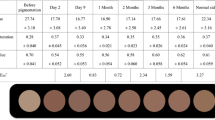Abstract
The evaluation of the surgical margins is a major concern in surgical pathology, and marking of surgical margins with substances such as alcian blue, Tipp-ex, artist's pigments, colored gelatin, starch, erythrocyte layers, etc. was recommended for this purpose; Indian ink and tissue marking dyes are widely used. As there is no systematic study comparing tissue marking dyes and Indian ink as the most common substances used for the purpose, this study was conducted to compare the two. Penetration into the tissue, brightness under the microscope, the spreading area of one drop of dye on tissue paper, the intensity of colors, and unit price were compared for each of the five colors of Rotring's Indian ink and Thermo–Shandon's tissue marking dyes, applied on reduction mammoplasty specimens. Rotring's Indian ink is proved to be just as effective as Thermo–Shandon's tissue marking dye and bares the majority of the characteristics of a perfect staining substance, which are easily applied, quickly fixed, durable and cheap, contain no potential contaminants, be work safe, would not smudge/stain surrounding tissues, and look bright under the microscope without obscuring the view.



Similar content being viewed by others
References
Dimenstein IB (2009) Grossing biopsies: an introduction to general principles and techniques. Ann Diagn Pathol 13:106–113
Armstrong JS, Weinzwieg IP, Davies JD (1990) Differential marking of excision planes in screened breast lesions by organically coloured gelatins. J Clin Pathol 43:604–607
Chan KW, Lui I, Chung WB (1989) Marking planes of surgical excision on specimens with mixture of India ink and acetone. J Clin Pathol 42:893
Chiam HW, Maslen PG, Hoffman GJ (2003) Marking the surgical margins of specimens: commercial acrylic pigments are reliable, rapid and safe. Pathology 35:204–206
Clarke TJ (1991) Differential marking of surgical excision planes. J Clin Pathol 44:87
Harris MD (1990) Tipp-ex fluid: convenient marker for surgical resection margins. J Clin Pathol 43:346
Paterson DA, Davies JD (1988) Marking planes of surgical excision on breast biopsy specimens: use of artists' pigments suspended in acetone. J Clin Pathol 41:1013–1016
Salerno A (1998) Fixing Indian ink on resection margins. Histopathology 33:284
Salerno A, Trent R, Jackson PJ, Cook MG (1995) A rapid and safe method to fix india ink on specimen resection margins. J Clin Pathol 48:689–690
Shinde V, Phelan C, Gater W, Thomas J (2008) Inking a specimen without the mess. J Clin Pathol 61:783
Wright RG, Osborne J (1991) Modification of the alcian blue method for marking breast biopsy specimens. J Clin Pathol 44:174
Hunter-Craig C, Lee-McDonagh B, Penman HG (1991) Marking of resection margins. J Clin Pathol 44:874–875
Prophet EB, Armed Forces Institute of Pathology (U.S.), American Registry of Pathology (1994) Laboratory methods in histotechnology. American Registry of Pathology, Washington
Corpas FJ, Chaki M, Fernandez-Ocana A, Valderrama R, Palma JM, Carreras A, Begara-Morales JC, Airaki M, del Rio LA, Barroso JB (2008) Metabolism of reactive nitrogen species in pea plants under abiotic stress conditions. Plant Cell Physiol 49:1711–1722
Miller L Stuff (2007) Quantifying western blots without expensive commercial quantification software. http://www.lukemiller.org/journal/2007/08/quantifying-western-blots-without.html. Accessed 10 March 2010
Molavi DW (2008) Prostate. In: Molavi DW (ed) The practice of surgical pathology: a beginner's guide to the diagnostic process. Springer, New York, pp 95–106
Conflict of interest statement
We declare that we have no conflict of interest.
Author information
Authors and Affiliations
Corresponding author
Rights and permissions
About this article
Cite this article
Kosemehmetoglu, K., Guner, G. & Ates, D. Indian ink vs tissue marking dye: a quantitative comparison of two widely used macroscopical staining tool. Virchows Arch 457, 21–25 (2010). https://doi.org/10.1007/s00428-010-0941-5
Received:
Revised:
Accepted:
Published:
Issue Date:
DOI: https://doi.org/10.1007/s00428-010-0941-5




